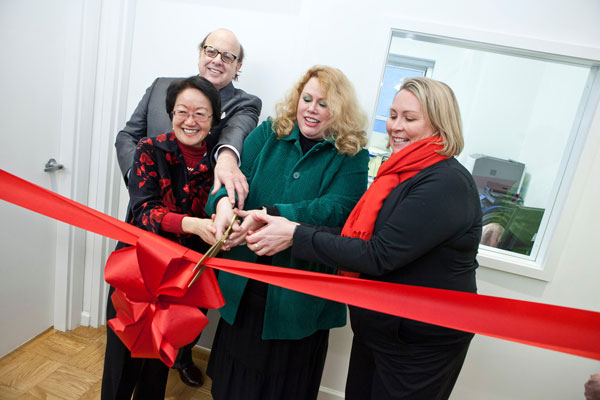
BY ALBERT AMATEAU | There was a joyful homecoming last week when Visiting Neighbors, which serves hundreds of seniors living alone in the Village, the Lower East Side and Chelsea, moved into its suite of just-renovated new offices in Washington Square Village.
As a nonprofit social agency with a budget that has been shrinking over the past decade, Visiting Neighbors has been operating out of a series of temporary locations, most recently a tiny windowless office on W. 14th St.
The wandering ended with a ribbon-cutting ceremony Thurs., Dec. 12, at 3 Washington Square Village, where Alicia Hurley, New York University vice president for government affairs and community engagement, and City Councilmember Margaret Chin welcomed Visiting Neighbors to its new 900-square-foot quarters in the N.Y.U.-owned residential complex.
“It’s wonderful to welcome Visiting Neighbors back to the Village and I’m happy to have been able to connect such a great agency with N.Y.U.,” said Chin, who brokered the agreement between Visiting Neighbors and the university as part of the city’s approval of the N.Y.U. 2031 redevelopment plan.
“We’re delighted to welcome Visiting Neighbors, an organization near and dear to N.Y.U., back to the Village,” Hurley said.
“Now we have a place to bring our volunteers to talk about the work we do,” said Cynthia Maurer, executive director of Visiting Neighbors. “It’s all about keeping our seniors safe at home in their loved community.”
Many of Visiting Neighbors’ volunteers have been N.Y.U. students, Maurer noted.
Founded in 1972, the agency provides shopping and escort services, friendly visits and special holiday programs to about 500 seniors.
“Our staff also provides training and advice for the volunteers who are at the heart of our agency,” Maurer said.
A core of about 200 volunteers serves in various ways. About 100 of them are assigned to escorting seniors to their medical appointments or to the supermarket, sometimes doing the shopping for homebound elders. Volunteers make friendly visits, some of them to their own special senior.
“We started in the Village, and over the years, kept getting calls for help from the neighborhoods north and south,” Maurer said. “It’s hard to say ‘no’ to people who need help.”
The volunteers range in age from 16 to 70 and the seniors include frail “youngsters” of 60 and people in their 90s. Most are above age 70 and the oldest is 106, Maurer said.
“Ten years ago the average age of seniors asking for help was 70 and now it’s 89,” she added.
It hasn’t been easy the past several years. Four years ago the grant from the city Department for the Aging was cut, leaving Visiting Neighbors to depend on its general public donors and its annual April Street Fair on Eighth Ave. in Chelsea. New rules about street fairs have further cut Visiting Neighbors’ income; the organization now has to share the street-fair income with other nonprofit groups.
Visiting Neighbors became unable to afford the rent on its former offices on Broadway at Houston St. and had to furlough its staff, reducing it from 13 to seven.
After several moves, Visiting Neighbors ended up on 14th St. and Eighth Ave in a 250-square-foot office with no window.
“I painted it sunshine yellow and turquoise and we made do. We still had to keep tabs on and serve hundreds of seniors,” Maurer said. “If I had to have a private conversation with someone, we had to go to a coffee shop across the street.”
Visiting Neighbors’ prospects for the future began to bloom last summer when Chin, a longtime supporter of the agency, found office space at N.Y.U. in connection with the 2031 redevelopment. The university agreed to make the new space available at a “utility rent,” considerably below market rate. N.Y.U. bore the $300,000 construction cost to get the space ready and promised to subsidize the rent for the lease’s first three years.
The past three weeks have been hectic. “We received notice that we had to leave the ‘cave’ on 14th St. earlier than we thought we had to, and it’s been a scramble to get everything ready. We’re still in boxes but we’re here and operating,” said Maurer.
Also as part of the university’s 2031 expansion plan, N.Y.U. has renovated and tripled the size of Creative Steps, an existing daycare center in 4 Washington Square Village. The $2 million reconstruction is nearly complete, and the 6,000-square-foot, state-of-the-art daycare, in partnership with University Settlement, will reopen in January for 75 preschool children from the community.
Despite the daycare and Visiting Neighbors projects, opposition remains to the 2-million-square-foot university expansion plan slated for N.Y.U.’s two South Village superblocks.
Mark Crispin Miller, a resident of 4 Washington Square Village and a member of N.Y.U. Faculty Against the Sexton Plan, which has an active lawsuit to block the 2031 plan, said later, “Such a renovation is all very well but it can hardly compensate the people living here, N.Y.U. faculty included, for the destruction of their neighborhood. We’re facing over 20 years of nonstop demolition and construction…so that N.Y.U. can ultimately make this part of the Village as appealing and affordable as Abu Dhabi… . We are not inclined to thank N.Y.U. for a bigger daycare center.”

















